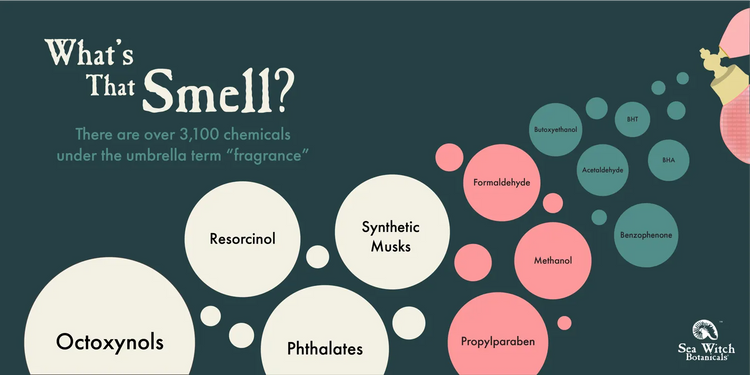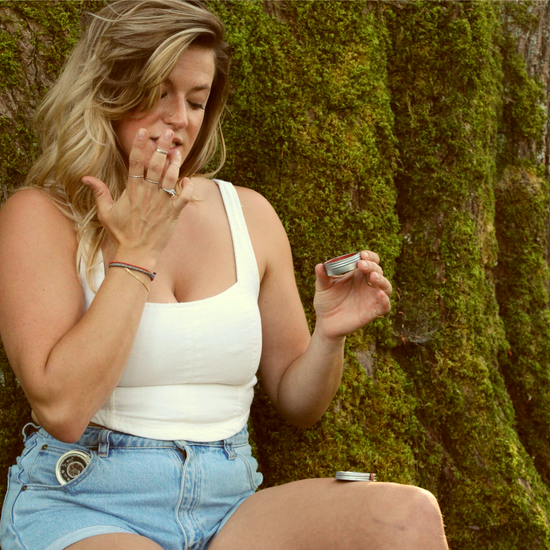What's in a fragrance?
Perfume, parfum, aroma, fragrance - these are all vague terms you’ve undoubtedly seen listed as ingredients in a plethora of personal care products. But what exactly is “fragrance”? A fragrance is loosely defined by the FDA as a combination of chemicals that give a product its scent.
There are well over 3,000 ingredients that are reported as being used in fragrance compounds. Products that list fragrance on their ingredients label may be using a medley of materials to make up a single aroma. In fact, in lab tests analyzed by the Environmental Working Group (EWG), researchers found an average of 14 secret, unlisted ingredients per product from 17 name-brand perfumes. Scented products can also contain solvents, stabilizers, UV absorbers, preservatives, and dyes.
Not all fragrance is created equal
Because fragrance compounds are marked as trade secrets, companies aren’t required to name the specific ingredients used. Many of these chemicals are known carcinogens, associated with hormone disruption, irritating to the skin and eyes, and/or linked to developmental toxicity.
An analysis of 3,163 chemicals in EWG’s Cosmetics Database found that 1 in 20 earned a “high” hazard score, and 16% rated at least a “moderate” hazard score. The database factors in availability of data on each chemical and rates known and suspected environmental and human hazards. Ingredients that rank a high score have been directly linked to serious health issues in government, academic, or industry studies.
These findings concluded with 25 chemicals rated a level 10 hazard, meaning they’re completely unsafe and confirmed to be toxic to humans. Among the worst offenders were octoxynols, nonoxynols, and phthalates. These chemicals are known hormone disruptors that bioaccumulate in the body (mostly in our fat stores), and are passed down from mother to child for generations to come.
In addition, another 19% of chemicals listed on labels haven’t even been assessed for safety by the fragrance industry.
The usual suspects
Unfortunately, many of these ingredients are unregulated and still in use in the United States (over 1,600 chemicals have been banned from cosmetic products in more than 80 other nations). You can find synthetic fragrances in deodorants, perfumes, facial wash, aftershave, soaps, and even garbage liners. To say they’re ubiquitous is, in fact, an understatement.
Luckily, the more consumers increase their awareness and demand better, the more companies create products that don’t use these harmful materials.
Easy swaps you can make today
Want to learn more?
We Sea Witches care deeply about the ingredients we choose to use in our products, and fragrance is a topic we're particularly passionate about. If you're interested in learning more about the effects of fragrance oils, are just getting introduced to essential oils, check out some of our blogs and favorite resources on the matter. If you really want a deep dive, sign up for our newsletter!
More from the Sea Witch blog:
- Are Fragrance Oils Safe For Our Health?
- You Burn It, You Breathe It: Which Candles Are Safest?
- Incense For Aromas & Anxiety
- Incense: Benefits, Use, History, & Health
Other favorite resources:
- The Case Against Fragrance by Kate Grenville. This book combines the author's personal journey with careful research into the science of scent. Grenville teaches us about the potential health risks of fragrance ingredients while uncovering industry secrets.
- EWG's Skin Deep Cosmetic Database. This database put together by the Environmental Working Group allows you to see the toxicity levels of common beauty products. It scans the ingredient list and shows which ingredients are the most hazardous.
- The Campaign for Safe Cosmetics. A project of Breast Cancer Prevention Partners, this site is a great resource for educational information. They're working hard to ban hazardous ingredients from use in cosmetics and increase transparency in the industry.
- The Secret Scents Report by Women's Voices for The Earth. Download this report to learn more about how hidden fragrance allergens harm public health.





